by Winding Pathways | Nov 29, 2018 | Garden/Yard, Mammals, Pests
After a balmy fall, the television weather report promised near record cold and snow in three or four days. Mice don’t have televisions but somehow, they knew this because several of the tiny mammals successfully entered our house just before cold arrived. One scurried across the floor as we were reading the morning newspaper.
Years ago we read our then young children a delightful book about a mouse in the house. The story goes: “There is a mouse in the house. It is a very nice mouse. It has a long, long tail and shiny eyes. My mother likes the mouse. But, she says, ‘A mouse does not belong in a house.’”
We agree and have developed a strategy to keep them out – at least most of them.
One tactic we do not do is poison. Karla Bloem of the International Owl Center in Houston, MN, reminds us that poison spreads. When a predator eats a poisoned mouse, it absorbs the poison. Over time, the poison builds up and kills the predator. People end up with more mice that can cause problems.
Here’s what we do at Winding Pathways:
- Encourage predators. We love to hear the barred owls call on dark evenings, and occasionally we spot a red-tailed hawk in a tree out the window. Both are outstanding mouse catchers. Owls work the night shift and hawks the day.
- Keep food secure. If mice smell dinner they’ll come right in uninvited and help themselves. It’s important to never leave food out unprotected. We store grain, flour, pasta, cookies and other foods in metal or stout plastic containers with tight-fitting lids. We don’t leave fruits and vegetables on countertops.
- Tighten up the house. Before it gets cold, we check our house over carefully. Any narrow cracks get filled with caulk. If we find a wider crack, we fill it with expanding foam. Often entry points for mice and insects are around pipes and wires leading into the home. Caulk and expanding foam help seal off the entry. Drain pipes sometimes are entry points. “Chore Girl” type metal cleaning pads work great for filling pipes where liquids or air needs to come and go. Wad up the metal pads and jam them into the pipe. Spaces in the cleaning pads let air and moisture enter or leave but keep mice out.
- Bring out the traps. Despite our best efforts, some mice make it into the house. Usually, we don’t see them but do see their calling cards – their tiny black droppings.
Effectively setting traps
Old fashioned mouse traps still catch mice efficiently, but a few tricks make success more likely. (With the exception of the poison information in this website, we have found this information to be appropriate.)
Bait. Probably the best bait is peanut butter. It just takes a tiny dab on the trigger to work.
Placement. Where you set traps is important. Mice naturally run along walls and dart under counters if they can. Traps set in the middle of a room are less likely to catch mice than those set along a wall with the trigger on the wall side.

Place several mouse traps where mice tend to enter.
Double up. It’s usually most effective to set several traps in the same spot. So, set two or three touching each other. The first trap or two might not catch the mouse. Usually one will
Keep setting the traps until you catch no more mice. Often people assume they have one mouse, but likely, there are more. Keep trapping until they’re all gone. We dispose of dead mice by simply tossing them outside for our local opossum to eat. They can be flushed down the toilet. Always be sure to wash your hands after handling mice or traps.
by Winding Pathways | Sep 27, 2018 | Bugs, Nature, Pests
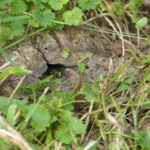
Yellow Jackets work the day shift.
We were recently concerned to find a Yellow Jacket nest close to our front door. Normally we appreciate their ambitious work catching insect prey. If they had made their nest in an out of the way place, we would have left them alone. But, their nest location invited painful stings to us or visitors. They had to go.
Several species of Yellow Jackets live in the United States. Most make an underground nest that can have an opening on the soil surface upwards of an inch in diameter. It can be nearly anywhere, but the nest we found was beneath the lawn next to the walkway into the house.
Yellow Jacket queens overwinter and begin laying eggs in the spring. By late summer or fall, the few Yellow Jackets that were around in spring have multiplied into colonies that can have hundreds of individuals. The workers die in late fall.
Many people discover a Yellow Jacket nest when they walk by it or mow the lawn over the entrance. Angry insects instantly attack and often a hapless person is stung many times in a second or two. Stings really hurt. It’s happened to us more than once, so now we don’t tolerate a nest near the house.
We only kill a Yellow Jacket colony if it’s located where we, or visitors, might be stung. Here’s how we do it:
Yellow Jackets work the day shift. Although they sometimes are out flying in the early evening by dark the entire colony is home underground in the nest. The nest entrance is easily spotted during the day by dozens of Jackets coming and going. We note its location. After dark we approach with a flashlight, spray can of insect killer, and a piece of cardboard, a board, or an old hunk of carpet. The flashlight helps find the hole. We spray a generous amount of poison down the hole, cover it with the carpet, board, or cardboard and weight it down with a rock. The covering keeps the spray in the nest.
The next morning, we watch for Yellow Jacket activity. Usually, there is none, telling us we destroyed the colony. We remove the covering, but if we see some Yellow Jackets we respray at night and cover the nest again. That usually solves the problem.
by Winding Pathways | Aug 23, 2018 | Pests
Lyme Disease Has Spread
According to National Public Radio physicians in all 50 states have reported treating cases of Lyme Disease. It is named for the town of Lyme, Connecticut, where it was first identified in the 1970s.
At first, the disease was confined mostly to the Eastern States and parts of the upper Midwest, but it has since spread widely, and the Center for Disease Control considers it one of the fastest spreading vector-borne diseases. Lyme Disease can cause fatigue, joint pain, and serious long-term problems. It is spread to people bitten by a tick so tiny that often the victim never sees it.
What’s Up With the Fatigue?
Rich contracted Lyme Disease in 2015 and again in 2018 and was successfully treated by Cedar Rapids Physician, Mary Anne Nelson, both times. His experience may help anyone who may have contracted the disease enjoy recovery from the disease. A major symptom can be fatigue.
“In 2015 I felt utterly fatigued for weeks on end. I never saw a tick or had a rash so didn’t suspect Lyme Disease. Because I wasn’t terribly sick I delayed going to Dr. Nelson until I started having knee joint pain. She prescribed a blood test that was positive for Lyme and treated it with powerful antibiotics. Fortunately, the medication worked, I had no side effects from the medication, and after a couple of months my energy returned as the joint pain faded,” he said.
Return of Lyme Disease
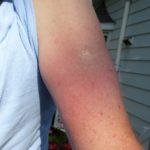
A common symptom is a generalized rash that is warm to the touch.
In 2018 a pinkish rash appeared on Rich’s left shoulder along with shoulder joint pain.
He immediately visited Dr. Nelson. She prescribed antibiotics, skipping the blood test. Symptoms vanished in a few weeks.
Not all Lyme victims are as fortunate as Rich and many struggle with the disease for years. Anyone who experiences the symptoms of rash, joint pain, or lethargy, even if they don’t feel terribly sick, should get to their physician right away. Early treatment may be most effective.
Hard to Detect
According to Dr. Nelson, Rich’s second round of Lyme was fairly typical. Like him, many victims are unaware they were bitten by a tick and often a pink rash is more common than the classic bullseye rash once thought to be a key symptom.
Lyme Disease isn’t restricted to people who slog through woods and prairies. The tick can lurk in yards, on golf courses, and in city parks. Although Lyme Disease is serious, remember, being in Nature offers tremendous health benefits. The risk of Lyme Disease shouldn’t discourage people from enjoying the outdoors.
Tips
Winding Pathways is concerned that people will shun the outdoors for fear of Lyme Disease. We encourage people to continue to enjoy their yards but be aware of the possibility of Lyme Disease, know its symptoms and take some precautions to ensure good health. Here are suggestions:
- Tuck long pants into socks to make it difficult for a tick to access the skin.
- Spray clothing with Permethrin. This chemical kills ticks and insects and is meant to be applied to clothing, not skin. It persists on clothes through several washings. Rich keeps a pair of permethrin-treated pants in the garage that he dons when working or walking in ticky areas.
- Purchase and wear clothing permeated with permethrin. Socks are available from Red Start Birding. A full line of clothing is available from Insect Shield. Local stores may sell permethrin treated clothes.
- After being outdoors take a sudsy shower and do a body tick check. Ticks sometimes walk on the skin for hours before biting. A tick strolling on the skin but not dug into the skin won’t cause Lyme Disease. Flush it down the toilet. Wash your hands.
- Be aware of symptoms. If a rash, lethargy, or joint pain appears get to a doctor right away.
Go Outside and play. The mental and physical benefits from contact with nature are huge. Just be tick aware.
by Winding Pathways | Aug 2, 2018 | Garden/Yard, Nature, Pests
Mugging Barberry

It’s a tough task eradicating Barberry.
One pleasant Saturday morning a couple dozen heavily armed people walked to the interior of Faulkes Heritage Woods. Their weapons were those used to help heal the forest and included thick leather gloves, lopping shears, hand saws, and clippers. They were out to defeat Japanese Barberry.
For two hours they attacked a huge patch of Japanese Barberry that had infiltrated the Woods. Grasping small ones with both hands people yanked them from the soil, shook them off and placed them so the roots would dry out and not re-root. In winter, when the Barberry has berries, the plants are placed on tarps and hauled off so the berries do not drop and root. Ones too big to pull were cut off at ground level.
Volunteers were organized by the Iowa Natural Heritage Foundation. It holds a conservation easement on the property that’s owned by the Marion City Parks Department. Park staff helped, and so did a crew of young people enrolled in AmeriCorps. Various local volunteers pulled and cut.
In Its Native Habitat, It is OK.
Just why is Japanese Barberry such an onerous plant? Actually, it’s a fine shrub in Japan and other parts of Asia where it’s native. There it has natural forces that keep its density in check. It was brought to North America as a landscaping plant because barberry is easy to propagate and transplant. It thrives in many locations, including compacted soil of building sites. It is an ideal landscape plant with one terrible trait.
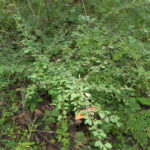
Barberry creates impenetrable tangles and changes the soil chemistry.
The plant produces red fruits in late summer that birds find delicious. They gobble them up, fly away, and poop the seeds out. So, birds snacked on barberries planted in yards and delivered the seeds into Faulkes Woods, where the seeds grow with gusto into impenetrable “pukka brush”.
Barberries crowd out native wildflowers and do much more damage. They actually change the soil chemistry to their advantage while making it less suitable for native plants. And, the dense shrubs create pockets of humidity. Each becomes an oasis of comfort for ticks.
Preserving and Exploring Faulkes Heritage Woods

Many hollows and ravines characterize Faulkes Heritage Woods.
Faulkes Heritage Woods is a gorgeous 110-acre steep forest adjoining Winding Pathways. We walk there often. Huge oaks and other native trees fill its wondrous spaces. Wildflowers abound, especially in the spring, and birding is excellent for woodland species. Pileated woodpeckers are common.
A looping footpath starts and ends at a trailhead off Tama Street Southeast. Visitors can park along the street and enjoy the woods. But, they don’t have to stick to the trail that only covers a small area. Walkers are welcome to go off trail and scramble through the woods to enjoy its beauty and solitude.
For information:
Marion Parks and Recreation: (319)447-3580
Iowa Natural Heritage Foundation: (515)288-1846
Winding Pathways LLC.
by Winding Pathways | Jun 28, 2018 | Nature, Pests, Trees/Shrubs

Poison Ivy loves edges
This summer millions of Americans will have unhappy encounters with poison ivy. For most people, the result is a patch of itchy bumpy skin that goes away after a few days to a week or so. Unfortunate others will develop a serious reaction that includes severe itching and swelling.
The very best way to not get a case of poison ivy is to avoid the plant and its culprit – urushiol, an oil that causes the allergic reaction. It’s on the plant’s leaves, in the vines and the sap.
Avoiding urushiol is a surefire way of avoiding a poison ivy rash, but many people have trouble identifying the plant. Fortunately, poison ivy has a secret. Knowing it helps people avoid the plant.
Poison ivy is an amazingly adaptable, hardy and confusing plant. It can be a low growing ankle high sprig, a shoulder high shrub, or a vine winding up to the top of a tall tree. The old saying “Leaves of three, let them be” is only partially helpful in identifying the plant. Usually, it does have leaves in groups of three but many animals love dining on poison ivy and are immune to its ill effects. So, a rabbit or deer may have eaten a leaf, giving the plant leaves of two! And many nonpoisonous plants have leaves of three.
Enter the plant’s secret. Poison ivy is a plant of the edge. It’s rare in the middle of a sun-soaked prairie or in a deeply shaded forest. The plant almost always hugs the edge of a habitat, especially if it gets partial sunshine.

Birds drop seeds when they perch on campground posts.
We’ve seen poison ivy on the edges of:
- Lawns, including ours
- The ocean sand dunes
- Lakes, especially along trails
- Roads
- Trails anywhere
- Ballfields – the rough where balls sometimes go
- Picnic areas
- It especially seems to love life in state park campgrounds especially around the posts that mark a site number and the trees that shade a campground area and that kids love to hug!
So, to avoid poison ivy be especially cautious on the edge. Look carefully at edge plants and study photos of poison ivy in books and on the Internet. Avoid poison ivy when you can.
But, if you accidentally touch the plant or have been wading through likely habitat, get home soon, remove clothes carefully, avoiding touching the outsides of clothes where poison ivy sap may have touched, take a sudsy shower, toss the towels in the laundry, and odds are good that the oil will be soaped off before it creates an allergic reaction.
by Winding Pathways | May 17, 2018 | Bugs, Garden/Yard, Nature, Pests
Creepy Crawlers
Even before Lyme disease created a serious tick-borne health hazard no one wanted ticks crawling on them. We sure don’t want them at Winding Pathways and because our yard has tall grass, shrubs, and a woodland we have tick habitat.
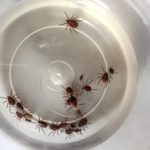
Collection of ticks
A few years ago, Rich contracted Lyme Disease caused when a tick injected bacterium into him. Thanks to a wise physician and effective antibiotics he was cured, but it’s possible to get Lyme Disease again and again. We’re more cautious about avoiding ticks now.
Ticks of many species live throughout most of the United States. They’re common in brushy, grassy, and woodsy habitat but they also love living in yards. It’s possible for a tick to enjoy a human meal even if that person never leaves a mowed yard.
Natural Tick Predators
Although naturalized yards are sometimes good tick habitat they also attract tick predators that love to snack on the tiny invertebrates. Many small birds, including warblers, wrens, and brown creepers among them quickly convert any tick they find into lunch.
Possums Are Us!

Opossums groom themselves carefully.
A newly understood tick-lover is the common opossum. Many people consider this ancient marsupial a homely animal and would prefer to not have one in their yard, but they might want to rethink this. According to the Carey Institute, opossums are tick vacuum cleaners. As they walk through a yard ticks hitch a ride, thinking they will be able to burrow into the animal’s skin and feast on warm blood. The tick doesn’t realize that possums groom their fur often and comb out ticks. These are readily eaten by the always hungry mammal. Having an opossum in the neighborhood can reduce tick numbers.
Foxes and Coyotes
Small predators, like the fox, are also valuable in tick reduction. According to a study by Dr. Hofmeester, Foxes and coyotes eat mice that ticks feed on. Ticks need three meals before they can reproduce, so more foxes and coyotes can reduce the mouse population and thus, the tick population by “…breaking the cycle of infection.”
Life Cycle
Tick numbers are also associated with climate change and abundance of food. Dr. William H. Schlesinger in an April 2018 issue of Citizen Scientist wrote about the work of Rick Ostfeld with the Carey Institute. The occurrence of ticks one year relates to mice numbers the year before, which relates to food abundance in previous years. The chain of life! And, according to Ostfeld, white-tailed deer are less implicated, unlike initial beliefs, and turkeys also appear to help reduce tick numbers. That is great news for us at Winding Pathway because the wild turkeys pretty much take over our yard at times!
Gobbling Guineas
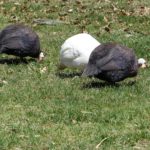
Guineas eat ticks.
A domestic bird that loves ticks is Guineas. They are tick lovers. They are African natives that have been domesticated. Elise Gallet de St Aurin, of Cheshire Moon Farms, told us the guineas that roam her farm near Atkins, Iowa, keep it clear of ticks. These attractive but loud animals roam widely, roost in trees, and eat all sorts of invertebrates, including ticks.
It’s impossible to buy or confine an opossum. But, guinea chicks can be ordered from Hoover’s Hatchery. Some people also enjoy eating guineas.
Repelling Ticks
A simple way to reduce odds that a tick will hitchhike on a person is to use repellents and chemicals that kill them. Any insect repellent containing DEET will repel ticks. Spray it heavily on the legs and arms and on clothing, especially pant legs, shoes, and socks. DEET doesn’t persist long and disappears after clothes are washed so it needs to be reapplied often.

Various forms of tick repellent.
A more permanent solution is to use a spray containing permethrin. This chemical actually kills the ticks. It lasts a long time, even through several wash cycles. It should not be applied to the skin. We spray it on our pants, socks, and shoes. One set of Permethrin-sprayed-pants remains hung in our cabin – not in the house – to put on when we are venturing in likely tick habitat.
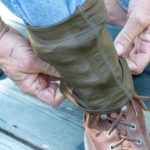
Protect yourself with gaiters
Ticks usually access a person from down near the ground. They’re most likely to cling to pant legs or socks and then walk uphill on the skin. Tucking pants into socks makes life harder for these pesky animals, and we take it one step further. We bought a pair of tick gaiters from Forestry Suppliers, Inc. They cost about $11 and fit over shoes and pant legs, forming a tight seal.
Tick Checks
Doing a “tick check” is important. After being outside take a hot sudsy shower and check the body over for ticks. Fortunately, they usually wander around on the skin for several hours before burrowing in. A tick that has not penetrated the skin won’t spread disease and often is simply washed down the drain. Launder the clothes right away.
Ticks deserve respect. They can spread serious disease and they lurk where people often go. Don’t let a fear of ticks keep you inside. Go outside and play but take precautions to reduce the chances of catching a tick-borne illness.













